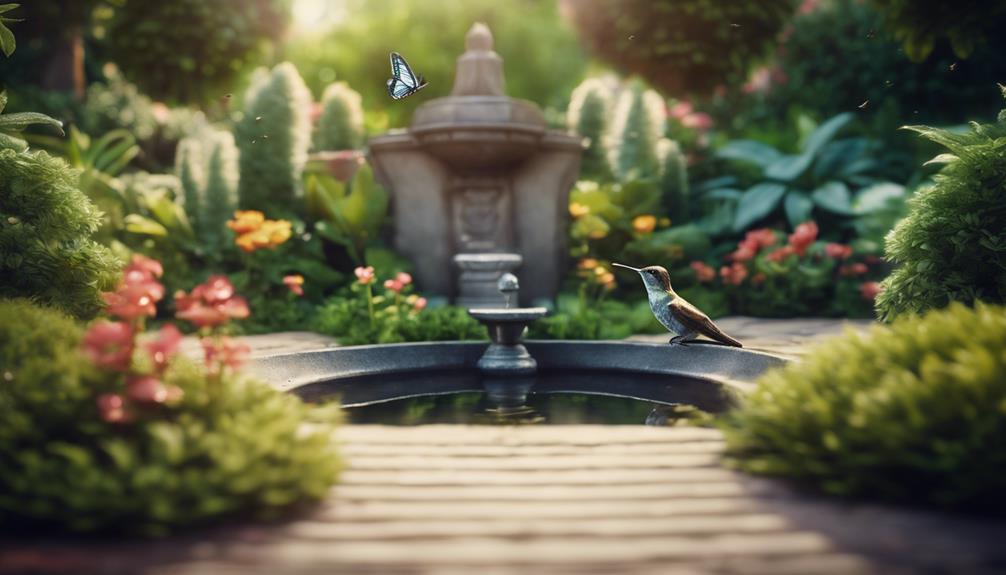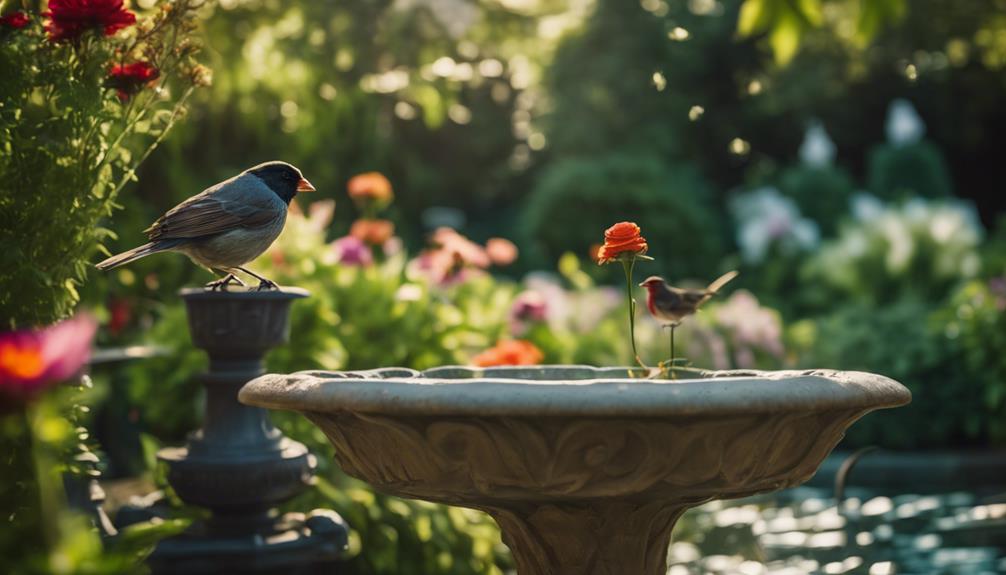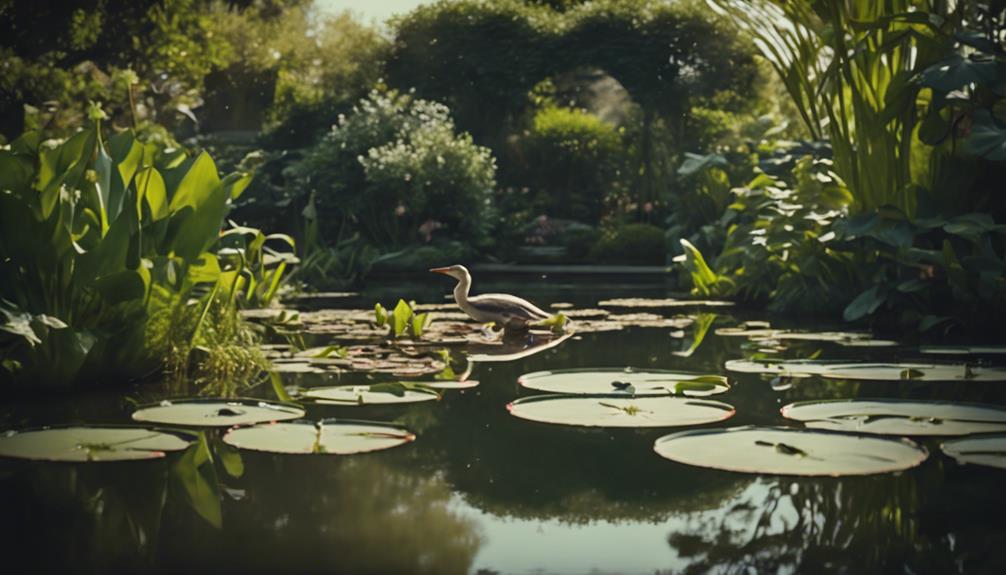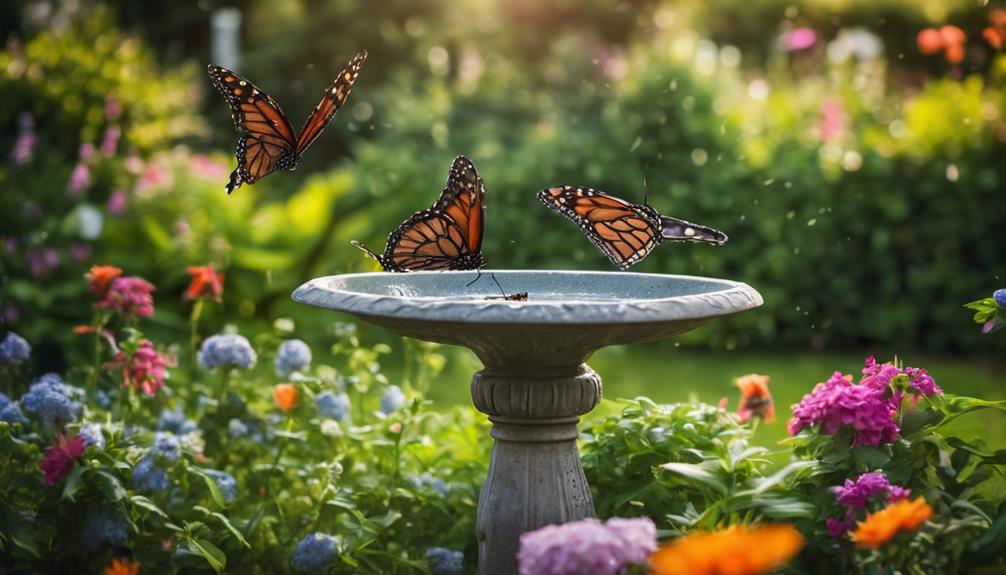By incorporating water features into your garden, you're providing a life-sustaining resource for local wildlife and creating a thriving ecosystem that benefits both the environment and your own well-being. Fresh water is essential for various species, and natural water sources can dry up during droughts, making artificial water features pivotal for supporting local wildlife populations. Attracting wildlife to your garden brings numerous benefits, including fostering biodiversity, reducing stress, and supporting local food chains. As you create a wildlife-friendly oasis, you'll discover the rewards of providing a haven for nature's creatures – and uncover the secrets to making it a success.
Table of Contents
Key Takeaways
- Attracting wildlife to your garden with water promotes biodiversity and supports local food chains, leading to a thriving ecosystem.
- Providing fresh water sources reduces stress and increases well-being for humans, while also supporting the daily survival of various species.
- Water features, like ponds and fountains, create habitats for diverse wildlife, from birds and insects to amphibians and mammals.
- A wildlife-friendly garden with water features fosters a sense of connection to nature, promoting a healthier and more balanced lifestyle.
- By attracting wildlife, you can create a natural and dynamic environment that is aesthetically pleasing and beneficial for both humans and animals.
Importance of Water for Wildlife
By incorporating a water feature into your garden, you're providing a pivotal component that's even more essential than food for attracting a diverse range of wildlife, as water is indispensable for their daily survival.
Without access to fresh water, many creatures would struggle to survive, making it a vital element in your wildlife-friendly garden. By providing water, you're supporting the daily needs of various species, from birds and insects to small and large mammals, amphibians, and invertebrates.
Natural water sources like vernal ponds can dry up during droughts, making artificial water features essential for supporting local wildlife populations.
A shallow bird bath is a simple yet effective way to provide fresh water, and adding irregular shaped stones allows birds and bees to perch and reach the water safely.
Any type of water feature can have a positive impact on the ecosystem, so don't be afraid to get creative and provide water in a way that suits your garden's unique style.
Benefits of Attracting Wildlife
Attracting wildlife to your garden brings a multitude of benefits, not only for the creatures themselves, but also for you and the ecosystem as a whole, as it fosters a thriving environment that promotes biodiversity and overall well-being. By providing water in your garden, you'll not only attract a wide variety of wildlife, but also reap the rewards of a healthier and more balanced ecosystem.
| Benefits | For You | For Wildlife |
|---|---|---|
| Reduces stress and increases well-being | ||
| Supports local food chain and biodiversity | ||
| Fosters a thriving and balanced ecosystem | ||
| Provides a habitat for various species |
Types of Wildlife-Friendly Water Features

Now that you've learned about the benefits of attracting wildlife to your garden, it's time to think about how to provide them with the water they need to thrive.
You'll be surprised at how many options you have, from simple bird baths and fountains to small water features, ponds, and bog gardens.
Bird Baths and Fountains
You can create a haven for wildlife in your garden by incorporating bird baths and fountains, which provide a vital source of fresh water for birds, bees, and other creatures.
A shallow bird bath is the easiest way to provide fresh water, and adding irregular shaped stones allows birds and bees to perch and reach the water safely.
Remember to clean your bird bath regularly to prevent algae buildup, and a daily-filled bird bath can sustain the needs of many creatures.
If you're looking for something more complex, a bird bath can be as simple as a shallow dish or as elaborate as a multi-tiered fountain.
Moving water features, like fountains, attract more wildlife than still water features, so consider adding a wall fountain that recirculates water into a small basin.
These are easy to install and perfect for small yards or patios.
Small Water Features
Set up a small water feature, like a bubbling boulder or wall fountain, to provide fresh drinking water for wildlife and create a lively gathering spot in your garden.
These small water features are perfect for small yards and can be as simple as a shallow bird bath or as complex as a multi-tiered fountain.
Moving water features, such as small fountains, attract more wildlife than still water features, making them a great option for gardeners.
You can choose a wall fountain that recirculates water into a small basin, which is easy to install and maintain.
Alternatively, you can create a container pond using a glazed pot or half of a wine barrel.
These small water features will provide water for birds and other wildlife, making your garden a welcoming haven.
Ponds and Bog Gardens
Create a serene oasis in your backyard by incorporating ponds and bog gardens, which offer a unique opportunity to attract a diverse range of wildlife to your garden.
You'll be surprised at how easy it's to set up a pond, even in a small space. Simply dig a hole, place a pre-formed pond shell, and add a small pump for a cascading waterfall. Line the pond with a rubber liner for a natural look and to prevent leakage.
Then, plant native water-loving plants like pitcher plants and Blueflag Iris, which provide shelter and food for various wildlife species.
Bog gardens are just as easy to create, requiring only a wet area of the garden or a rubber-lined planted area kept moist throughout the year. This provides a habitat for amphibians and other wildlife.
Designing a Wildlife-Friendly Fountain
Frequently, a thoughtfully designed fountain can become the crowning jewel of a wildlife-friendly garden, providing a vital source of water and attracting a diverse range of species.
When designing a wildlife-friendly fountain, you'll want to incorporate natural materials like stone or wood to blend into the environment and attract wildlife. The sound of flowing water will draw in birds and other animals, and decorative elements can create a cohesive space around the fountain.
To cater to different species, consider a fountain with varied water depths, including shallow areas for small birds and insects to bathe and drink, and deeper sections for larger birds and small mammals.
Make sure to include accessibility features, such as shallow edges or rocks, to increase the appeal of the fountain to wildlife.
Creating a Pond or Bog Garden

How do you envision transforming a corner of your garden into a thriving oasis that attracts a diverse range of wildlife, from dragonflies to frogs, and adds a touch of serenity to your outdoor space? Creating a pond or bog garden can be a great way to achieve this vision. With a few simple steps, you can create a haven for aquatic plants and animals.
| Ponds | Bog Gardens |
|---|---|
| Can be lined with a rubber liner for a natural look | Simply a wet area of the garden or a rubber-lined planted area |
| Can be designed to attract specific species of wildlife | Provide a unique habitat for plants that thrive in wet conditions |
| Can be planted with water-loving plants like pitcher plants and Blueflag Iris | Can be planted with water-loving plants like pitcher plants and Blueflag Iris |
Small Water Features for Wildlife
As you design your garden to attract wildlife, consider incorporating small water features that'll make a big impact.
You'll be amazed at how these miniature oases can provide essential resources for your feathered and furry friends.
Bubbling Fountain Benefits
By incorporating a bubbling fountain into your garden, you'll not only provide a vital source of fresh drinking water for local wildlife, but also create an engrossing focal point that attracts birds and other animals.
The gentle movement and soothing sound of the water will draw them in, making your garden a haven for wildlife. Plus, during times of drought, your bubbling fountain will be a lifeline for thirsty creatures.
The best part? Installing and maintaining a bubbling fountain is easy, even in small gardens or urban areas. You can get creative and use a glazed pot or half of a wine barrel to create your fountain, making it a low-cost and eco-friendly option.
As you sit back and enjoy the tranquil atmosphere your fountain creates, you'll know you're not only attracting wildlife but also contributing to their well-being. By providing water and a sense of calm, you'll be creating a welcoming space for both humans and wildlife to thrive.
Fresh Water Sources
You can create a haven for wildlife in even the smallest of gardens by incorporating small water features that provide fresh water, a essential resource for their survival.
Wildlife need water to drink and bathe, and a daily-filled bird bath can sustain the needs of many creatures.
One easy way to provide fresh water is by creating a shallow bird bath with irregular shaped stones, allowing birds and bees to perch and reach the water safely.
You can also repurpose a glazed pot or half of a wine barrel to create a small water feature, making it easy to add a water source to even the smallest of gardens.
Wall fountains and container ponds are also great options for small yards, as they're easy to install and maintain, and can be placed in a variety of locations.
Moving Water Attracts
Moving water features, like bubbling boulders or small fountains, are a magnet for wildlife, drawing them in with their dynamic sounds and visual appeal. By incorporating moving water into your garden, you'll attract a wider variety of wildlife than with still water features alone. The movement and sound of running water create a sense of energy and life, making your garden a more appealing destination for wildlife.
| Option | Benefits |
|---|---|
| Wall Fountain | Great for small yards, easy to install, and provides a source of moving water |
| Container Pond | Perfect for small spaces, can be created using a glazed pot or wine barrel, and adds movement with a small pump |
| Small Pump with Pre-formed Pond | Creates a cascading waterfall, attracting more wildlife than a still pond |
Whether you opt for a small urn or a large pond with a waterfall, moving water features will attract wildlife to your garden. By choosing the right option for your space, you'll create a welcoming oasis that will bring joy and connection to nature right to your backyard.
Bird Baths for Fresh Water Access

Providing a reliable source of fresh water is essential, and a well-maintained bird bath can be a lifesaver for thirsty birds, especially during dry spells or harsh winters.
You can create a welcoming oasis in your garden by incorporating a bird bath that's easy to access and clean. Use water that's changed regularly to keep the water fresh and free of bacteria.
A clean bird bath is vital, as dirty water can spread diseases among birds.
When choosing a bird bath, consider one that's shallow with a rough surface, allowing birds to easily land and take off.
You can also add some rocks or twigs for perches. Place your bird bath in an open area, protected from strong winds and predators.
Keep the water level topped up, and clean the bath regularly to prevent algae growth.
Moving Water Features Attract More
As you create a haven for wildlife in your garden, incorporating moving water features can substantially enhance their appeal, drawing in a diverse range of creatures with the mesmerizing sights and sounds of flowing water.
Compared to still water, moving water features like small fountains or bubbling boulders are more attractive to wildlife because they stimulate their senses with sound and sight.
A daily-filled bird bath with moving water can sustain the needs of many creatures, from birds and bees to small mammals and amphibians, providing them with water to drink and a hub for wildlife activity.
The gentle movement of water also creates a sense of security, mimicking the natural movement of streams and rivers. Plus, moving water features reduce stagnation and algae growth, making them more appealing to wildlife.
With options ranging from small wall fountains to large ponds with waterfalls, you can customize moving water features to fit any garden size, making them a versatile option for attracting wildlife.
Improving Water Quality for Wildlife

By maintaining pristine water quality, you'll create a safe haven where wildlife can thrive, free from the threats of algae growth, disease, and parasites.
As you provide water for wildlife, it's vital to prioritize water quality to safeguard their health and well-being.
Properly aerate, circulate, and filter your ponds and fountains to prevent algae growth and maintain water quality.
Regularly clean bird baths and water features to prevent the spread of diseases and parasites among wildlife.
Introduce mosquito-eating fish or biological control methods to maintain water quality and prevent stagnant water that attracts mosquitoes.
Test and maintain ideal pH levels (between 6.5 and 8.5) to support aquatic life and maintain water quality.
Safety and Refuge in Water Features
Create hiding places and sheltered areas within your water features, like submerged plants, rocks, or sunken logs, to offer wildlife a sense of security and refuge.
This will encourage them to visit and stay in your garden. By providing protection from predators and harsh weather, you'll make your outdoor space a welcoming haven for wildlife.
Natural water features, such as ponds or streams, can be especially effective in providing shelter and refuge.
You can also create hiding places by incorporating native aquatic plants, which will also help to maintain good water quality.
Make sure to include easy access points, like shallow areas or gradual slopes, so wildlife can easily enter and exit the water.
By incorporating these features, you'll be creating a safe and inviting space for wildlife to thrive.
As a result, you'll be rewarded with a vibrant and diverse range of visitors to your garden, and a deeper connection to the natural world.
Strategic Location for Wildlife Attraction

When planning your garden, strategically locate features that attract wildlife in areas that receive the right amount of sunlight and protection from harsh winds, certifying that your outdoor space becomes a magnet for local species.
This thoughtful approach will encourage wildlife to visit and stay around your water features, providing them with a welcoming habitat.
To maximize wildlife attraction, consider the following:
- Place your water features in a spot that receives partial shade, especially during the hottest part of the day, to prevent water evaporation and keep the water cool.
- Certify your water features are accessible to birds to drink and bathe, with shallow areas and gentle slopes for easy entry and exit.
- Position native plants and flowers around your water features to provide shelter, food, and breeding grounds for wildlife.
- Create a diverse habitat by incorporating different water depths, flow rates, and aquatic plants to attract a wide range of species.
Frequently Asked Questions
Why Have a Water Feature in Your Garden?
You have a water feature in your garden because it adds decorative accents, creates stunning focal points, and boosts visual appeal, making your outdoor space a serene oasis that invites relaxation and connection with nature.
Should You Put Out Water for Wildlife?
Will you be the lifeline for thirsty creatures? You should put out water for wildlife, as they desperately rely on it, especially during water scarcity and seasonal needs, and it's their survival that's at stake.
Why Is Water so Important for Wildlife?
You understand that water is crucial for wildlife because it supports habitat diversity, ecological balance, and species survival, as it provides essential hydration, sustenance, and breeding grounds, ultimately ensuring the thriving existence of diverse species.
What Attracts Animals to a Garden?
You attract animals to your garden by providing food sources, shelter provision, and scent marking opportunities, creating a welcoming habitat that meets their basic needs and draws them in, making them feel at home.
Conclusion
As you create a haven for wildlife in your garden, remember that water is the elixir of life.
By incorporating water features that attract and support wildlife, you're fundamentally playing the role of a modern-day Noah, providing a safe haven for creatures great and small.
Your garden will become a thriving oasis, teeming with life, just like the Garden of Eden.
So, plunge forward and create a watery wonderland that will make the creatures of the wild sing your praises!

